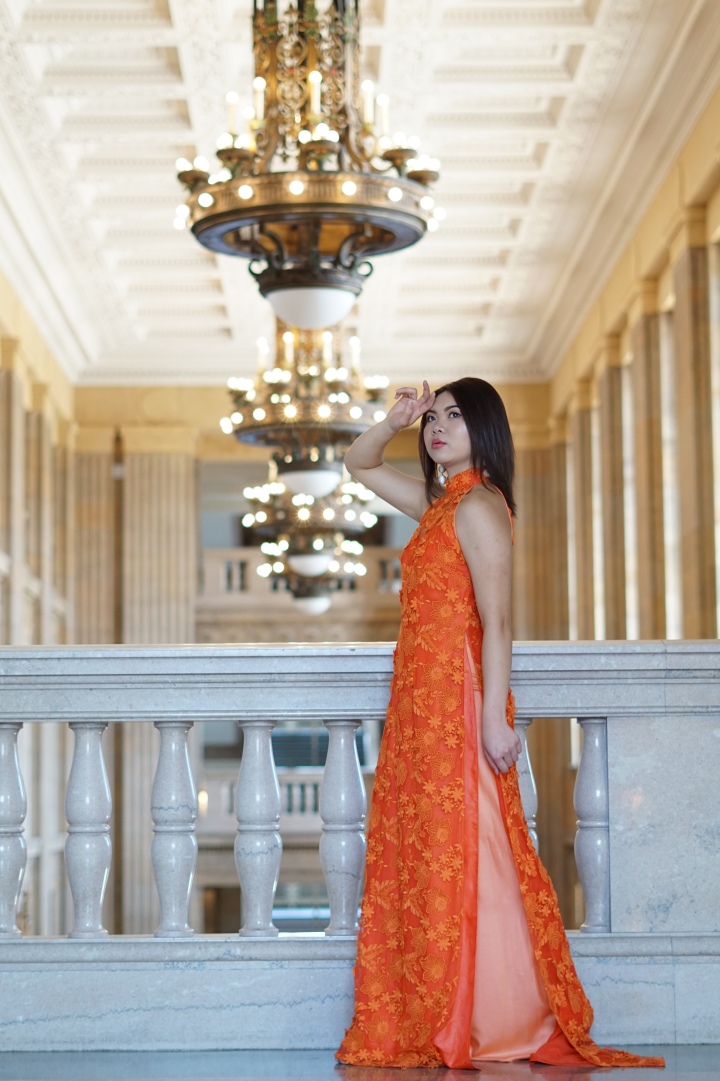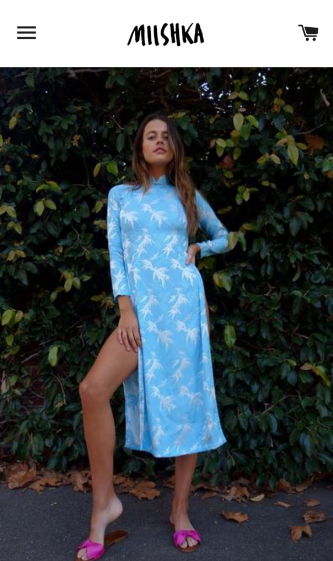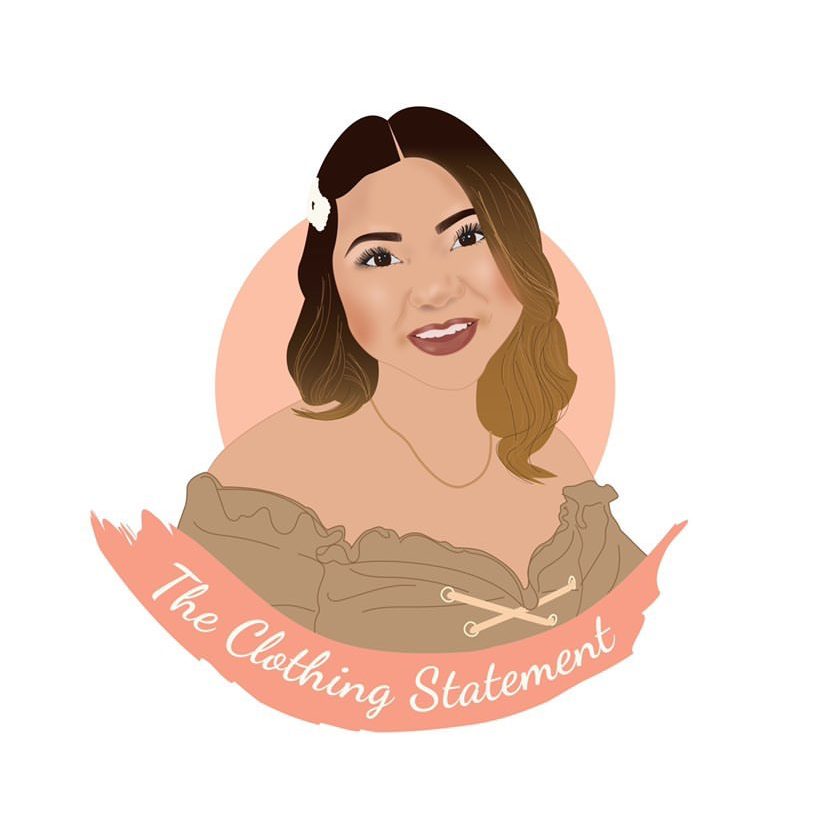

Before I start this post, I would just like to give a special thanks to this week’s photographer, Charlie Cao, and my makeup artist, Hannah Chen for helping me with this post. Without them, none of this could’ve happened! Feel free to check out Charlie’s Instagram account here, and Hannah’s makeup account here! This week’s post is by far my favorite article that I’ve ever written and it means a lot to me. I hope that you’ll love it as much as I do.
…
Recently, I started a new segment called “The Clothing Statement”, which features fashion trends or clothing pieces that I think make a statement or create heavy impact on society. Last time, I posted about”Gender Neutral Fashion“, but for this week, I’m focusing on the importance of the Vietnamese áo dài (pronounced “ow yai”). About a month ago, I came across some photos that an Australian clothing brand called Miishka, posted of a model wearing what looked like an áo dài– except it was shorter, and she wasn’t wearing any pants. The Miishka website listed the áo dài as a “90’s Vintage Oriental Dress” and was selling it for $95. Aside from this áo dài, they were also selling clothes that resembled the cultural clothing of multiple different countries and trying to pass them off as “vintage” and “high-fashion.” When I saw this, I felt completely devastated and astonished.


My thoughts ran wild. This is cultural appropriation! How could someone wear my cultural clothing in such a distasteful way? How could a clothing brand try to take my culture and turn it into some sort of club attire?! But what occurred to me was, people can be ignorant or oblivious. So, I’m taking matters into my own hands to show you the beauty of what the áo dài is, how it came about, and why it’s so important to me.

“áo dài” directly translates into English as “long gown”. Today, the áo dài is very form-fitting, has a front and back flap, the right side of the dress has many hooks or buttons that are used to give the dress shape, and it’s worn with long, loose pants that hug snugly around your waist. Áo dàis are made out of light-weight and expensive materials such as velvet, silk, or satin. They come in all different colors and designs. Traditionally, Vietnamese women wear white as a symbol of innocence and youth, thus, you’ll find that female students in Vietnam will wear white áo dàis to school. Red on the other hand, is a symbol of love and maturity, which is perfect for a woman to wear on her wedding day. Although some colors have deeper meanings, many people will simply pick colors and fabrics that they like and use whatever they think will look the most flattering.

The áo dài wasn’t always like this, though. Historically, Vietnamese clothing has gone through many different political changes to reach this point. Not a lot of people remember, but Vietnam used to be ruled by China, and eventually, colonized by France. Each time Vietnam was colonized, the áo dài went through changes in design. Under China, the áo dài’s design was inspired by Chinese fabrics and incorporated the diagonal button closure of the garment, which may explain why áo dàis slightly resemble the traditional Chinese attire “qipao”. Under French colonization, the áo dài adapted to a tighter form which showed off a woman’s curvature and required women to wear corsets, many designers also incorporated lace, puffy sleeves, and an overall more Westernized feel to the traditional Vietnamese attire.

The effort to gain freedom from foreign colonization is what led to the current design of the áo dài. Today’s áo dài represents Vietnamese pride, our people’s identity, individuality, beauty, and grace. New modifications have been made to the áo dài which includes features inspired by Western fashion. The new modifications add sensuality, and now the garment is able to delicately shift with the body to give the wearer an appearance of modesty, combined with self-confidence.

Yes, I am proud to be an American citizen and enjoy the democratic lifestyle here in the United States, but Vietnam is also home. I’ve moved away from Vietnam at the age of one, but it’s still a huge part of who I am. Truthfully, I used to be ashamed of being Vietnamese because it made me different from everyone else. I didn’t understand why on every special occasion my mom put me in an áo dài and I never wanted to pick up my parents’ phone calls because I didn’t want to speak in Vietnamese in front of my friends. But now as I’ve become older, I am incredibly appreciative of my Vietnamese roots. I speak Vietnamese because I want to retain my language and I proudly don my áo dài with pride and elegance. Vietnam is the country in which my parents fell in love, where my siblings and I were born, where most of my family members still reside, and its language will forever be my mother tongue. This is why the áo dài makes a “Clothing Statement”.

Hopefully by now, you can understand why I’m deeply hurt by Miishka’s decision to appropriate my cultural clothing and exploit it as “oriental vintage” clothing. The áo dài has such a deep and meaningful background, coming about through hundreds of years of colonization, pain, suffering, and political change. I truly hope that all of you reading can feel my sincerity and understand my reasoning behind why I am taking a stand to reclaim the áo dài for the Vietnamese people.

Dear Miishka,
This is how you wear a Vietnamese áo dài.


I love it when girls speak out for what they believe is true. How dare Miishka do this to something of high cultural meaning. It’s sad that these fashion houses try to make other cultures “cool” by misrepresenting them.
First time on your blog, and I learnt a lot about the “ow yai” from your post today. Thanks.
http://www.lilyofnigeria.com.ng
LikeLiked by 1 person
First and foremost, welcome to The Clothing Statement! Secondly, thank you so much for giving this article a read and for providing me with feedback. Through this segment on my blog I’ve been able to speak out about more issues that are important to me!
LikeLike
Yes! This entire post is illuminating! You are showcasing what it means to be Hamy, to be the representation of a history, of a culture! Yes! Please send and tag that company in this post! Go off Hamy!
LikeLike
Thanks for always supporting me, Hercules. Your kind words mean the world to me ❤️
LikeLike
I agree 100%!! Thank you for posting this! I was upset seeing the pictures of what they portrayed the ao dai as. It was insulting in a way. The dress has always been a symbol of elegance and beauty and you rocked it with those photos! You wore that dress beautifully and as a fellow vietnamese, this post made me proud that someone put the correct message across. I recently posted a few ao dai dresses of my wedding on my blog and I love those dresses. They are timeless beauties! You’ve said it well in this blog!
https://ayennyformythoughts.wordpress.com
LikeLiked by 1 person
Thank you so much for reading and leaving such kind words. I’m glad that as a fellow Vietnamese, you could relate to this post. I’ve checked out your wedding blog post and I must say, I love your Ao dais! They look so elegant on you and I’m happy that you were able to incorporate them into your wedding day.
LikeLike
Hello, thank you for a very enlightening read! I was wondering what your thoughts are on western women wearing ao dai?
I am in Vietnam at the moment, you see, and I have for a long time admired the elegance of the ao dai and would love to buy on for myself but I realise that it may seem offensive to some to see a white european woman wearing one…
I really admire the dress and the culture but I can understand if it holds too much cultural significance for me to wear it – especially when it is, as you explained, a symbol of Vietnamese pride.
I hope to hear your thoughts on the matter!
LikeLike
Hello! Thanks for taking the time to read my blog post. This is always a tricky question but I would say since you’re in Vietnam right now and have always admired the ao dai, it wouldn’t be offensive to me to have you purchase one as long as you’re wearing it the correct way. It’s nice to see Vietnamese culture be appreciated by others!
LikeLike